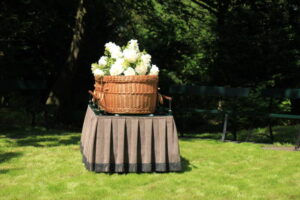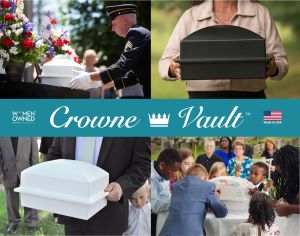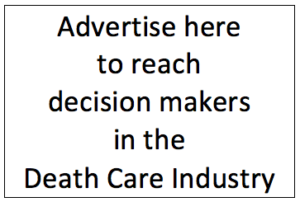Green Burials. . . . . .The Resistance

Minnesota funeral director Scott Mueller is a proponent of “Green Burials”. Mueller makes a comment in this recent article from the Rochester (MN) Post-Bulletin titled “As interest in green burials grows, so does some opposition”. Mueller’s comment is this, “As long as people have walked this earth, we’ve had green burials. Every cemetery around here, until the 1940s, has green burials.”
While there are two Minnesota cemeteries that the article states are green burial cemeteries, the article also makes note of at least two instances where Minnesota authorities have either stopped or delayed the establishment of cemeteries proposed for green burials. One in Carlton County where, according to the article, neighboring property owners objected and one in Winona County where the county attorney issued a cease-and-desist order.
The conflict in Carlton County, again according to the article, “prompted lawmakers to put a moratorium on natural burial cemeteries in order for the Minnesota Health Department to study the environmental and health impacts of green burials and human composting.”
Based on that report both the Minnesota House and Minnesota Senate designed bills about the establishment of new green cemeteries. In both of those bills the legislation proposed that no more than 300 burials per acre be permitted and the proximity to bodies of water be established. Neither bill made it to a floor vote by the end of the Minnesota Legislative Session for 2025 but proponents of green cemeteries were not fans of the limited burials per acre. In the article Mueller states, “Nobody is going to pursue that because there isn’t going to be enough acreage or enough revenue to justify that.”
Minnesota eventually lifted the moratorium on green cemeteries and effective in July 2025 Minnesota became the 11th state to legalize Natural Organic Reduction (NOR), known by some as human composting. However, as of this writing I’m not aware of any facility that is operating or applied for a NOR permit.
Mueller, in the linked article, says these methods of human dispositions are a reflection “. . .of a shift in cultural priorities. Fewer people are affiliated with religion and people are embracing environmental awareness. . . . . .I think a funeral should reflect our lifestyle and should reflect what’s important in life. It represents my choice, it is important to me having an impact on the environment. If I can express that through my death, that’s important to me.”
Related articles about pushback from these methods of disposition — Human composting, alkaline hydrolysis not acceptable for burial say U.S. bishops. National Catholic Reporter (2023 article)
Funeral Director Daily take: Scott Mueller, who by the way, is a classmate of mine from the University of Minnesota and a consumate proponent of “serving the families who call him” , makes good points in this article. Rochester (MN) funeral director Colin Maxon also makes good points in the article when he says, “We try to accommodate what people are wanting.”
If what people want are more simple, green options, the industry and eventually laws will change. “That barrier is going to break at some point,” continued Maxon.
From my point of view we live in a society where people want options that fit their own attitudes and beliefs. We no longer live in the era when Henry Ford made this quote famous, “Any customer can have a car painted any color that he wants so long as it’s black”.
It’s my opinion that if funeral homes are not going to provide, or facilitate, disposition options such as natural organic reduction, green funerals, and alkaline hydrolysis someone else in the community will and will siphon off customers over the years as these methods become more popular. I think it is imperative that funeral homes work with their legislators to get these disposition methods approved as long as public health is maintained in doing so. To fight the processes simply to force client families to go out of state or use the disposition methods available at your funeral home today will, again in my opinion, not be good for the long-range financial health of Death Care providers.
About the Henry Ford quote: I was aware of the quote and decided to use it in this article. However, when looking it up I learned that while it is a true quote atrributed to Henry Ford, customers could get their Model T in other colors. Here’s what I learned about the Model T manufactured between 1914 and 1925:
“This (paint color) policy was not arbitrary but stemmed from a focus on efficiency, as black paint dried much faster than other colors, allowing for quicker assembly-line production and lower costs. While the policy became prominent between 1914 and 1925, the Model T was available in other colors before and after this period.”
More news from the world of Death Care:
- Americans choosing cremation at historic rates, NFDA report finds. Cision PR Web
- Kent State hosting launch event to highlight partnership with Cincinnati College of Mortuary Science. Morning Journal (OH)
- Brunswick funeral home offers to examine ashes after Kingsland pet crematory probe. Video news story and print article. News 4 Jacksonville (FL)
Enter your e-mail below to join the 3,201 others who receive Funeral Director Daily articles daily
“A servant’s attitude guided by Christ leads to a significant life”






















Re: green burial. I would think that a properly embalmed body in a casket with a suitable burial vault would be much more environmentally friendly than decomposing human remains leeching into the water aquifer. What makes the traditional burial service not good for the environment?